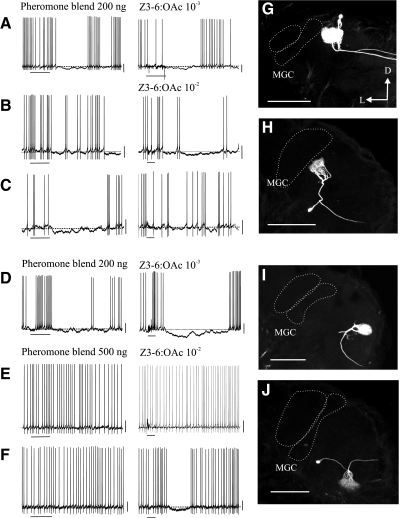FIG. 3.
Responses and morphological features of PNs in sexually isomorphic glomeruli. A–C, G, and H: PNs in glomeruli adjacent to or 1–2 glomeruli away from the MGC and G35; D–F, I, and J: PNs in glomeruli distant to the MGC. Records shown in A, B, D, and E were obtained, respectively, from the neurons shown in G–J. PNs in both adjacent (A and G) and distant (D and I) glomeruli were inhibited by stimulation with either odorant. PNs in both adjacent (B and H) and distant (F and J) glomeruli were inhibited only by Z3-6:OAc. C shows an example of a PN that was inhibited only by the sex pheromone, and E and J show an example of a PN that was not inhibited by either key component of the sex pheromone. PNs were stimulated with the odor compounds and concentrations indicated. The respective control stimuli (cyclohexane and mineral oil) elicited no response (not shown in this figure). The resting potential is indicated (···). These results show that not all PNs, regardless of their position, receive inhibitory input from the MGC or G35 (or any other glomeruli activated by Z3-6:OAc). Calibration bars: 10 mV in all records. Scale bars = 200 μm. ···, the outline of the MGC glomeruli. The cell body of the PN shown in I (not visible in this section) was in the anterior group of neuronal cell bodies.

